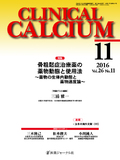Japanese
English
- 有料閲覧
- Abstract 文献概要
- 1ページ目 Look Inside
- 参考文献 Reference
薬物による治療効果や一部の副作用の強さは,当該薬物や活性代謝物の体内での濃度に依存する。薬物の生体内濃度を定量的に理解するのが薬物動態学である。薬の効果は,しばしば患者の主観に強く依存したり,数値として測定することが困難なことがある。そのような場合であっても薬物動態を理解することにより,薬によって患者に起こる事象を定量的に把握することができる。本稿では,薬の体内での濃度がどのような要因によって決まり,どのように定量的に扱うかを,骨粗鬆症治療薬での具体的な例も交え概説する。
Pharmacological outcome and a certain side effects of therapeutic drugs generally depend on concentration of the drugs and/or their active metabolites in the body. Physiologically-based pharmacokinetics is quantitative tool to understand the drug concentration in the body. Drug efficacy is sometimes affected by subjective factors and cannot be clearly quantified. Even in such cases, it could be possible to quantitatively understand possible pharmacological events occurred in the patients by understanding pharmacokinetics of the corresponding drug. Here, we have attempted to summarize the basis of physiologically-based pharmacokinetics to understand which factors will determine drug concentration in the body and how to predict/speculate the drug concentration in the body in a quantitative manner. For easier understanding by the readers, we introduce some examples of pharmacokinetic property of several osteoporosis drugs.



